The Creator Economy has grown dramatically over the last few years. More than 50 million people globally consider themselves content creators, and you can see the appeal. A hobby that many started in their bedrooms has now become a lucrative career.
According to a 2022 report by Influencer Marketing Hub and Refersion, the influencer market grew from $1.7 billion in 2016 to $9.7 billion in 2020. That is projected to reach $16.4 billion by the end of 2022, and this is only set to increase further as brands continue to invest heavily in influencer marketing.
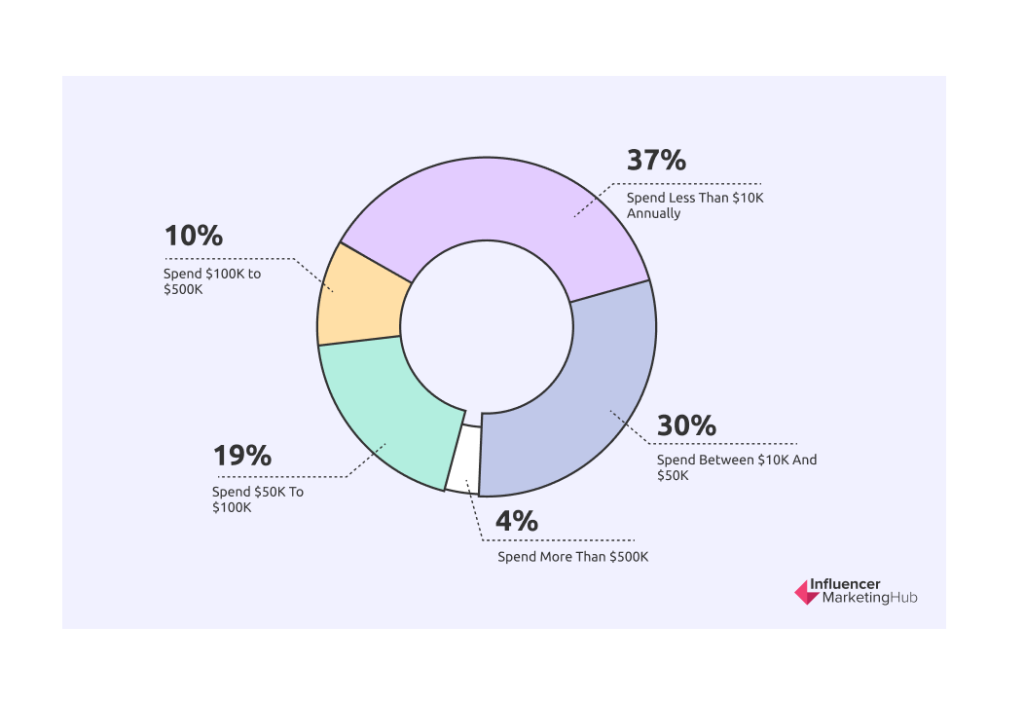
While some people believe that influencer marketing is just a fad or that the demise of influencers is coming, the data shows the opposite. Influencer Marketing Hub found that more than 75% of brand marketers intend to dedicate a budget to influencer marketing in 2022. Of that, 68% of respondents intend to increase their budget over the next 12 months while only 3% intended to decrease their budgets.
There’s no denying the power of influencer marketing in today’s digital age.
When it come to influencer marketing something that comes up time and time again is authenticity. It’s a buzzword that is thrown around within the creator community, with experts advising influencers to ‘be themselves’ and ‘be transparent’. The recommendation is that influencers need to be both aspirational and relatable in order to succeed.
However, the growth of digital has seen a new breed of influencer emerge. Influencers that only exist virtually. These influencers cannot inherently be authentic because they themselves are not real. Is this the future of influencer marketing?
What is a virtual influencer?
Virtual influencers look and act as real people online but as the name suggests, these influencers do not actually exist. They aren’t real or human. Instead they are generated by computers and exist virtually within a curated digital world.
They are created by tech-savvy digital teams who have crafted them from scratch – everything from their physical appearance to their fictional personalities. Because of the nature of their creation, they are often referred to as CGI (computer-generated imagery) or AI (artificially intelligent) influencers.
Although the concept of virtual influencers started in 2016, it isn’t exactly new. We grew up with cartoons and characters like Mickey Mouse, Tony the Tiger and Jessica Rabbit. We also had the Gorillaz, an English virtual band created by Damon Albarn and Jamie Hewlett. The four animated members of the Gorillaz appeared on our TV screens. They won awards, performed live tours and appeared on MTV Cribs as digital creations.
Virtual influencers really started gaining traction when they popped up on Instagram in 2018. One of the first to appear was Miquela.
The most popular virtual influencers
Lil Miquela
Miquela Sousa is a self-proclaimed 19-year-old robot living in LA. The Brazilian-American model was created in 2016 by Brud, a Los Angeles-based startup led by Trevor McFedries and Sara DeCou. In January 2019, TechCrunch reported that Brud had closed a $125 million investment round sparking conversation that virtual influencers are the future.
Although hard to believe, people are invested in Miquela’s life. Miquela amassed over one million followers on Instagram by April 2018 and over 3 million as of April 2022. She’s also active on Twitter, Tumblr, YouTube and TikTok but it doesn’t stop there.
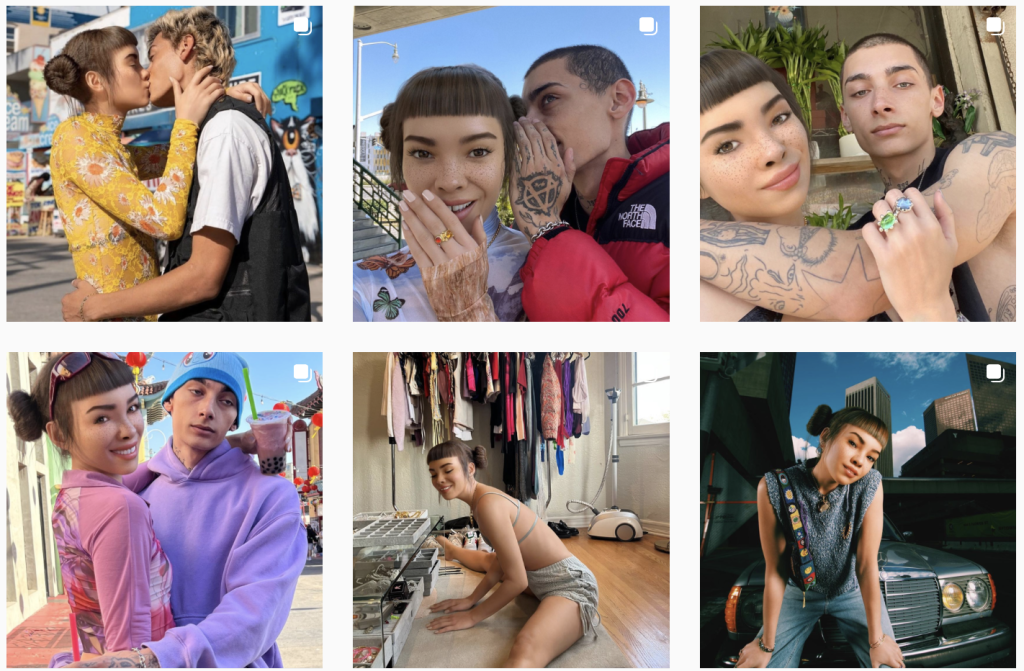
Miquela has worked with the likes of Calvin Klein, Prada and Nike. She has been featured in a number of different publications including Vogue, Business of Fashion and Nylon, and pictured with Millie Bobby Brown, Bella Hadid and other celebrities. Miquela was even named one of Time’s 25 most influential people in June 2018.
Bermuda
Bermuda is an LA-based “It Girl” and aspiring musician, who wants to inspire young entrepreneurs in the tech and beauty sector. We first came across her in April 2018 when she hacked Miquela’s account. Bermuda replaced photos of Miquela with photos of herself. However, it turned out that Miquela and Bermuda were both created by the same team.
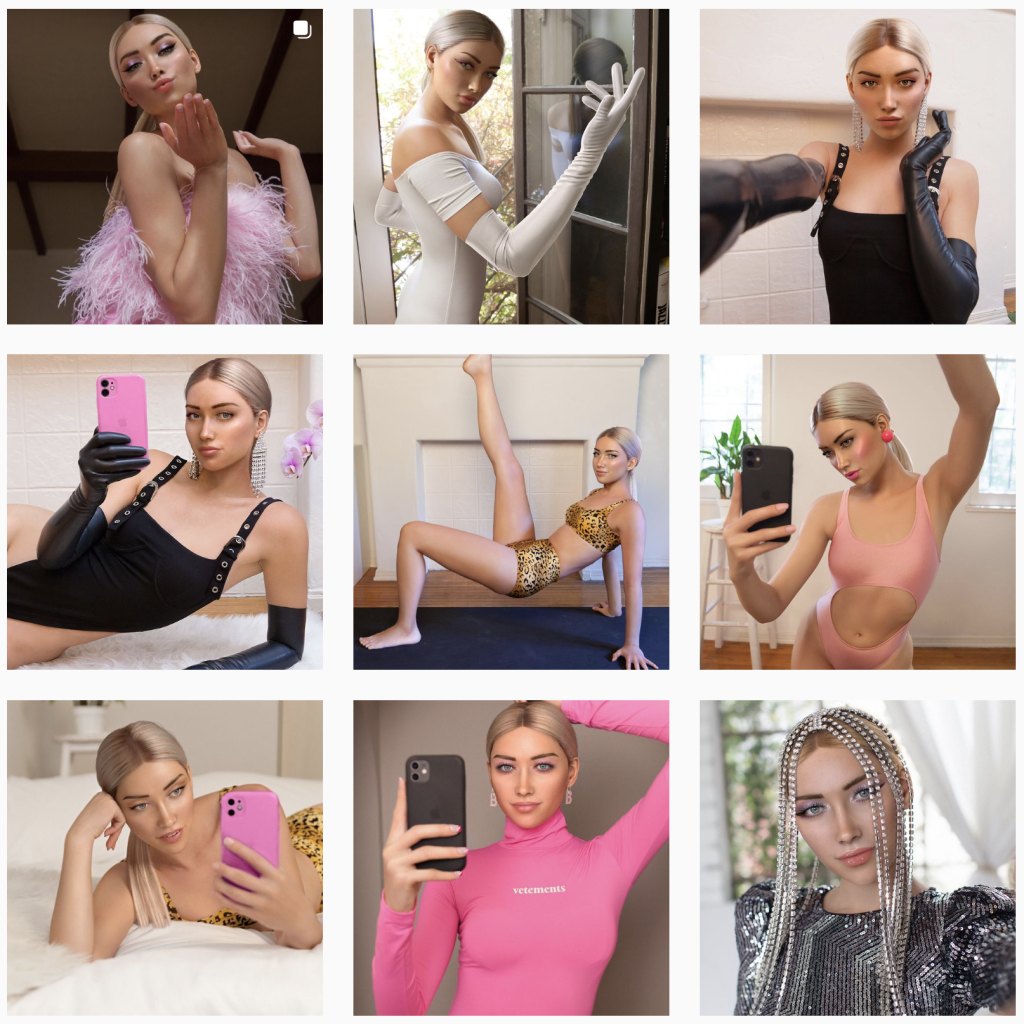
Miquela and Bermuda had an on-going feud before finally becoming friends. Yes, virtual influencers have friends and foes. They also fall in and out of love. Bermuda’s ex-boyfriend Blawko, another virtual influencer, shared their breakup story in a YouTube video which has multiple comments on it thanking him for being “so real” and honest about his history with Bermuda.
While Miquela is the most popular virtual influencer, Bermuda often gets referred to as the most controversial. She’s described as problematic and trashy. She also regularly got called out for being a Trump supporter – though she has apparently changed her views on that.
Shudu
Shudu Gram is a South African model in her 20s who started her Instagram account in April 2017. She describes herself as “the world’s first digital supermodel” and has worked with the likes of Cosmopolitan, Vogue, Fenty and Balmain.
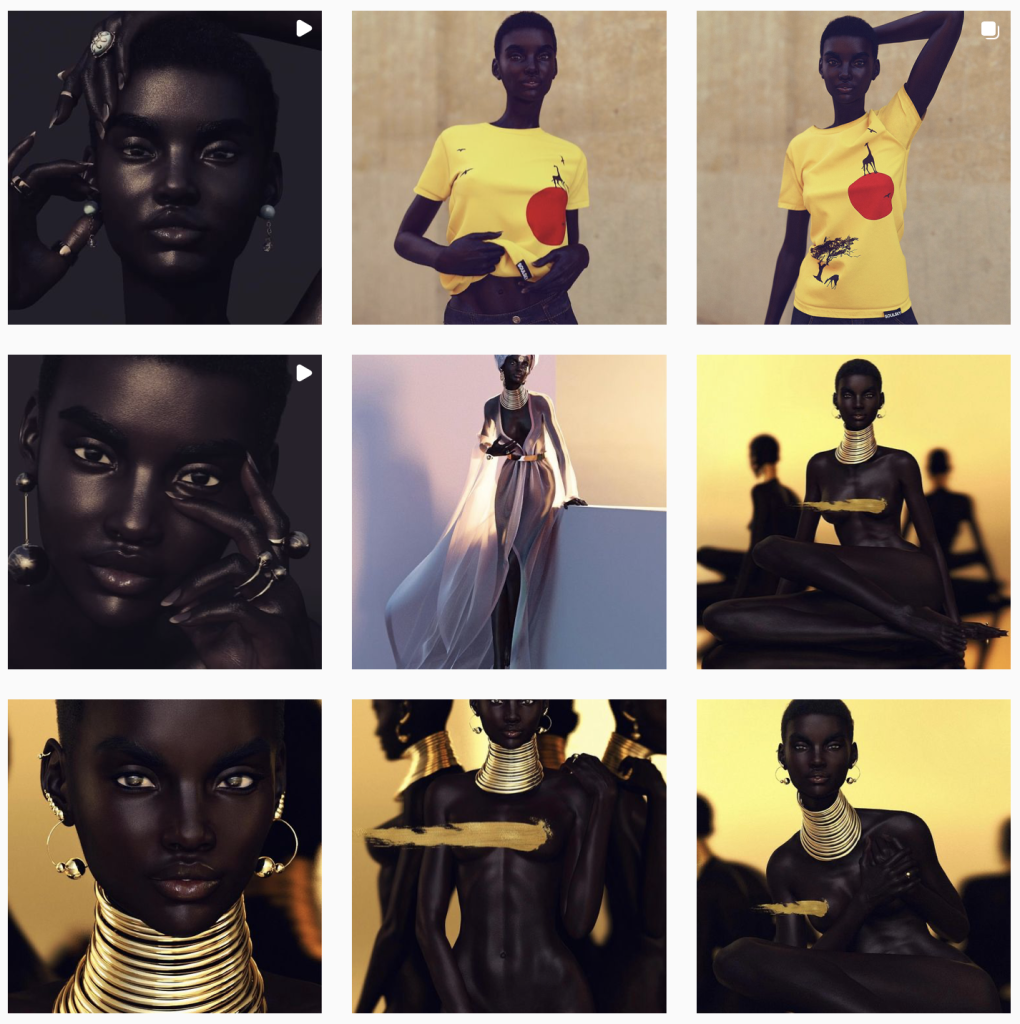
Described as the “Princess of South Africa”, Shudu quickly gained popularity on Instagram as viewers expressed awe at her beauty and her page went viral with fans using the #BlackIsBeautiful hashtag.
However, this virtual influencer caused a lot of controversy as Shudu was in fact created by a white man, a fashion photographer from the UK called Cameron-James Wilson. While some call him out for cultural appropriation and racism, others have praised him for creating a wider diversity of virtual influencers, which they believe will push the industry to become more inclusive.
Why brands are working with virtual influencers
The major appeal of virtual influencers is that they can be moulded more easily to fit the needs of the brand. Brands have more flexibility and control over content with virtual influencers, and less risk of them making mistakes or drawing negative attention. It also signals that your brand is on top of the latest trends.
The fashion and tech industries have taken to virtual influencers like no other. Lil Miquela attended the Prada FW18/19 show in Milan, sharing her day on the brand’s Instagram Story. That same year, Shudu Gram was announced as part of Balmain’s virtual model army. Prada have even created their own virtual model to promote their perfume line. And in 2020, Burberry introduced a CGI digital double of model Kendall Jenner for their summer collection.
When it comes to the tech-world, virtual influencers exist beyond human possibilities. The fact that they are themselves digitally created makes them a great fit for tech brands. Lil Miquela featured in Samsung’s 2019 #TeamGalaxy campaign promoting the idea that just like Miquela, a Samsung phone can offer limitless possibilities.
The controversy surrounding virtual influencers
As we’ve briefly discussed above, one of the major issues with virtual influencers is that they can be created by anyone and designed in any way. Should Cameron-James be allowed to profit from Shudu? Should brands use Shudu to promote their products and benefit from seeming diverse? These are questions that have been raised.
Can we trust virtual influencers in the same way? It seems so, as research conducted by UK’s Mindshare Futures revealed that 54% of all UK consumers find visual entities appealing on some level.
Human influencers are often called out for supporting multiple brands, being dubbed “sell-outs” for their Instagram Feeds being heavily sponsored. But how do virtual influencers compare in this regard.
And while human influencers are slated for their unrealistic lifestyles, virtual influencers also sell an idyllic picture-perfect one. They’ve been crafted by a team of designers, does this set another layer of unrealistic standards that is already so prevalent on social media?
Conclusion
Influencers initially gained their popularity by being authentic and relatable. Will virtual influencers be able to amass the same kind of loyal following without that personal connection?
Will Robots Take My Job show a 93% risk of modelling being replaced by automation, the same can likely be said for the influencer industry. However virtual humans describe virtual influencers as the influencers of tomorrow and as we move into Web3, I’m inclined to agree.
Are virtual influencers the future or is it a fad? Let me know in the comments below or join me on Instagram to find out more about content creation.
Recommended reading:
- What is a Virtual Influencer? Virtual Influencers, Defined and Explained
- Lil Miquela and the virtual influencer hype, explained
- The Problematic Fakery Of Lil Miquela Explained
- Why Diversity and Inclusivity in Virtual Influencers Matter
- Virtual Influencers: The Future of Fashion
- Why the Tech Industry Loves Virtual Influencers
- CGI influencers: when the ‘people’ we follow on social media aren’t human

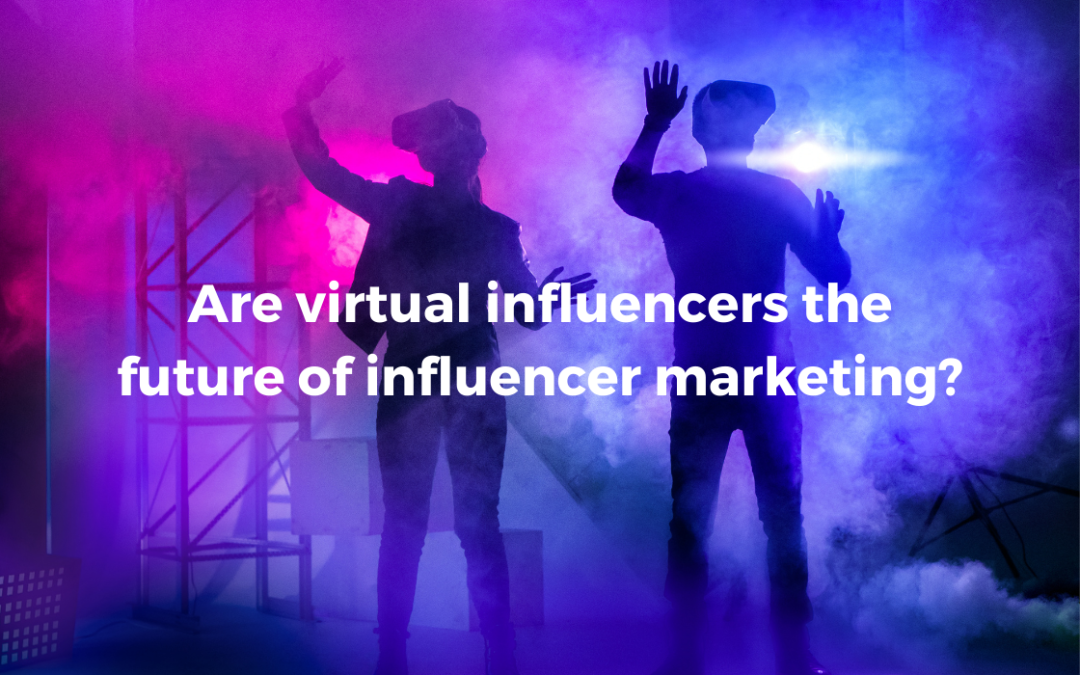
So interesting! I think there will always be room for both. More and more we’re seeing body positivity movements and whilst virtual influencers can help with promotion, the connection to real bodies with flaws, scars and the stories behind them, will always be needed and wanted.
So true, I can’t relate or connect to virtual influencers in the same way!
Exciting to learn how fast this market is growing – great article!
Thanks Jeppe, it really is an exciting time!
Exciting developments in this space! Interested to learn more on how this market progresses.
Will definitely be interesting to see, companies are already spending a fortune with both real and virtual influencers.
Very interesting article
Thanks Joel!
Considering that the metaverse is likely to be the next big frontier, it would make sense that virtual influencers and brands take center stage. I had never even heard of any of these projects and yet they make complete sense and seem like a natural successor to the current state of the “influencer” in social media.
I agree, it definitely seems like the next natural step! It fits so well within tech and fashion especially, but I wonder if it would work as well in other industries. I guess time will tell!
Realty just hit me in the face, this article was super informative and an interesting read. I’m not so sure if I should be nervous or scared nevertheless this is an exciting time.
It’s definitely an exciting time, but I get what you mean. There’s something very iRobot about the whole thing! Thanks for reading Tyla.
Very interesting article, I don’t see why virtual and human influencers can’t work together. Both have special qualities which will always be needed from both.
Thanks Nicole! Agreed, there’s definitely space for both, and benefits for both also.
Definitely interesting to see more of virtual influencers. As it stands, influencers globally often have a negative affect on many peoples self esteem, and body image as it seems far fetched to the everyday person. So definitely down for more relatable everyday virtual influencers.
Thanks for reading Celina. That’s a great point, some relatable less-than-perfect virtual influencers would be great to see.
Very interesting and thought provoking piece!
I hadn’t previously known of these virtual influencers, I would’ve thought that they were real people!
Presumably, brands would feel more comfortable endorsing these virtual influencers as they have less risk of the individual’s behaviors being linked or tarnished by their personal actions.
Although, do you have the same relatable experiences with a virtual influencer? Would they ever do wrong or share a topical opinion? I would presume not, although I guess it allows them to focus on creating their own story & world for people to explore and get inspiration from. You touched on this with characters like Mickey Mouse, I guess there’s a space for both fact and fiction (real/virtual influencers), and individuals will be drawn to different characteristics, genres and themes, much like the world and characters we see in movies, games and books influence our lives.
How could these virtual influencers be expanded in the future and what other roles could they take up?
It brings up a lot of questions that only the future can answer, great article!
Thanks Conor, a great comment from you also! It is crazy, if you just scroll by you would think they were real. That’s a great point too that we’ve previously been drawn to characters in movies, games and books. Definitely brings up a lot of questions about what the future will look like, I guess we’ll get some insight into that with the Metaverse.
A thought-provoking article indeed.
Thanks for reading Danny!
Great article and well written with a lot of information re possible trends in the future and some great comments.
Thanks for reading Ron!
I was ok with virtual influencers but the great detail and information on this page made me re-think my position
I think I sit in the grey area here, can see both sides – the good and the bad. Thanks for reading!
Great article, learned a lot about a topic I didn’t know much about before!
Thanks Elaine, appreciate you taking the time to read!
Great to have all facts about influencer marketing and virtual influencers summarised in an accessible article. Enjoyed reading this!
Very interesting topic! Virtual influencers are so controversial yet so popular. I’m interested to see how they evolve into virtual worlds.
Thanks Mollie! For sure it’s a grey area, but I guess as it evolves we’ll see changes and perhaps even some regulations around it too.
Mind is blown here ! Thanks as always for sharing content that I wouldn’t come across usually
Thanks Louise, glad you found it interesting!
Very interesting article. I liked what you said about it being new but not new, it is similar to other characters we grew up with only they are now being presented on social media and have deeper personalities. Great read!
Thanks Kay!
Quite interesting! I wonder how virtual influencers will shape the future..
Thanks Sesil
An interesting read! I find it amazing how the world has changed and is now so accommodating to a virtual world, even in virtual influencers!
It is pretty mind-blowing, thank you for reading!
Such an interesting reading! When I first run into a virtual influencer on Instagram, I wondered how this could be a good idea, but then I checked the number of followers they had and all the positive comments they received… and I was shocked! I personally believe that we mostly like influencers because of their authenticity, because they’re real and relatable. Therefore, I don’t think that virtual influencers will ever be able to replace real ones or even pose a threat to them. However, you can never know what will happen in our digital-first world, so we just need to wait and see.
Thanks Francesca. The number of followers and positive engagement does surprise me too, because like you, I’m interested in influencers that I can connect with. I don’t bond with virtual influencers in the same way. But like you said, we never know what will happen.
I forgot to add that it’s quite hilarious to know that a virtual influencer can be controversial and can be called out for being a Trump supporter!
Isn’t it! I found so many negative comments about that aspect of ‘her’ views
Nice article Elaine… I wasn’t aware of this concept before reading this post. Thank you
Thanks Lavin, appreciate it!
What is interesting to me is how these influencers can often influence in a disingenuous or negative way and it isn’t monitored. I wonder if others share my views of the needs for greater regulations into this.
Great article that is not only informative but though provoking.
Thanks Danny. Totally agree, great point and something I could discuss further. Some influencers are really doing some great work and I’ve been lucky enough to work with them. But unfortunately there are some who are negatively using their large platforms and spreading misinformation which can be dangerous too. Especially when their target audience is younger generations. Appreciate you sharing!
I would be really interested in any further article you do on the impact it has on young people. As a professional in the education sector I am always looking out for ways we can help influence young people positively and I agree a lot of online content does this, but it needs monitoring.
Times are changing and we need to make sure it’s for the better!
Agreed! Thanks so much for your comments Danny, would love to write about this topic more in the future.
Really enjoyed learning from your article Elaine!
So interesting to hear that they already existed before Instagram with the likes of Mickey Mouse and Jessica Rabbit.
I guess Barbie would be one of the big ones amongst influencing young children – I wonder if she’ll become a more proactive virtual influencer once the metaverse becomes more accessible? Maybe she already is 😱
I’ll definitely be looking up the three most popular virtual influencers you mentioned in the article, I’m so intrigued!
Barbie! What a great example, definitely one of the biggest influences on younger children and we’ve seen her digitised so yes, I wonder if she’ll evolve again. Thanks for reading and sharing your thoughts Nadia.
This is a very interesting blog! I never thought that virtual influencers are so popular. Well done Elaine!
Thanks so much Stalo, appreciate it!
Very interesting topic! Virtual influencers are the future!
Thanks Trayana!